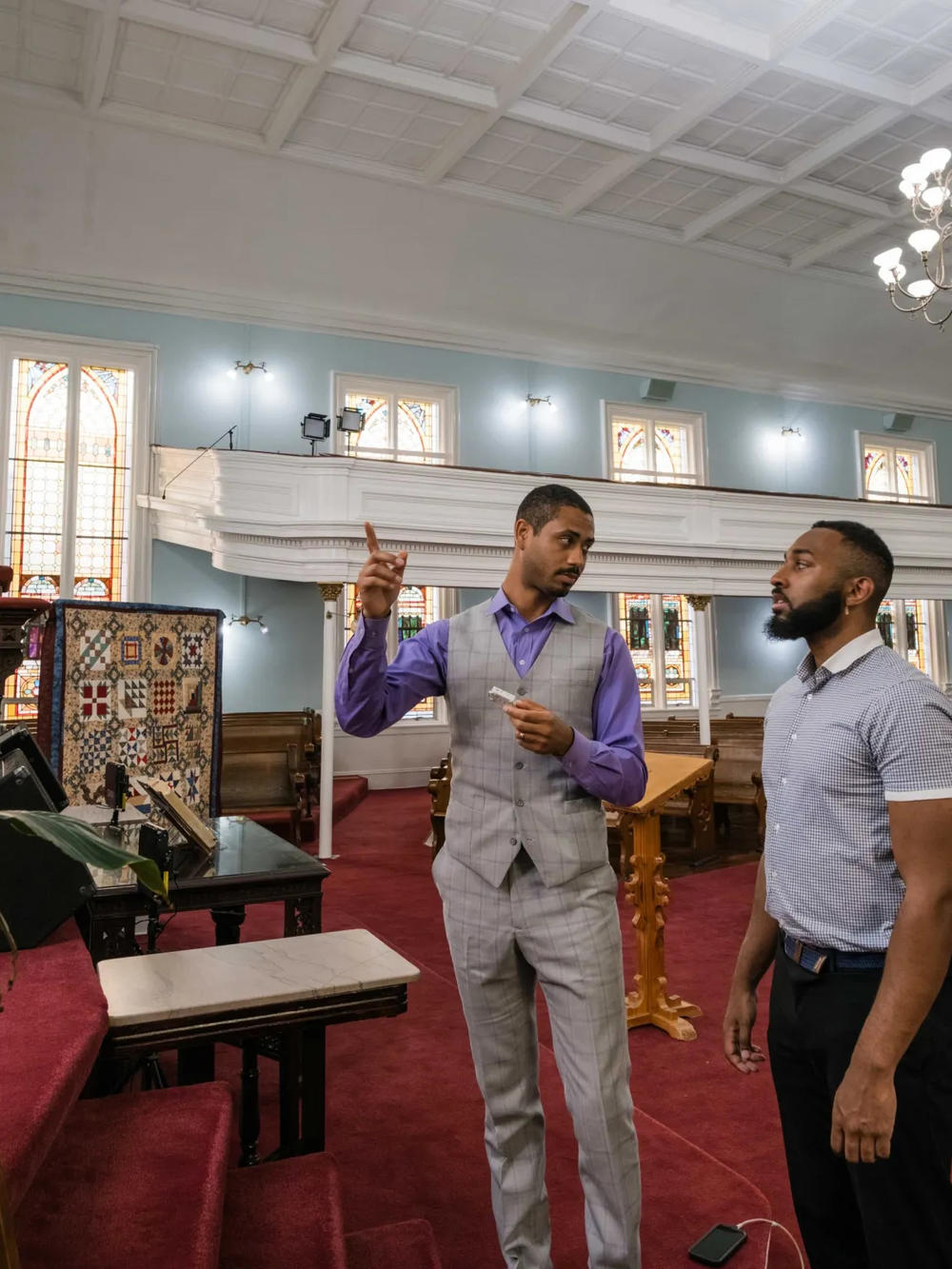
Caption
Using an infrared thermometer to measure the heat put out by an LED light bulb, a worker conducts an energy audit of a historic Black church building.
Credit: Justin Taylor / The Current

Using an infrared thermometer to measure the heat put out by an LED light bulb, a worker conducts an energy audit of a historic Black church building.
Mary Landers, The Current
First African Baptist Church, among the oldest continuous African American congregations in America, could be among the first Black churches in Georgia to produce its own electricity.

Anthony Kinslow uses an infrared thermometer to measure the heat put out by an LED light bulb at First African Baptist Church.
“This church right here is the example,” Anthony Kinslow of Washington, D.C.-based Gemini Energy Solutions said at the downtown Savannah church Thursday. “We are starting a feasibility study to develop a revenue-generating micro grid here at this church, which will include solar PV, charging stations, battery storage, and any energy efficiency upgrades that are needed.”
Gemini is partnering with Oakland, Calif.-based Green the Church, a nonprofit that aims to “expand the role of churches as centers for environmental and economic resilience” to improve energy efficiency and alternative energy production at places of worship across the country. In Georgia, the partners aim to reach 100 Black churches by the end of the year.
It’s a natural for First African Baptist, said its pastor, the Rev. Thurmond Tillman.
“We understand the importance of being able to do what we can to assist our community in taking care of what God has given unto us,” Tillman said at the press conference kickoff event at his church. “And we have to do our part. The earth is the Lord’s and the fullness of the world. And they they dwell therein. And those of us who dwell therein are the ones responsible for making sure that the right thing is done.”
For years, solar panels were too expensive for most churches and other nonprofits to consider. Federal tax credits that cut costs by up to 30% were available to homeowners but inaccessible to churches that don’t pay taxes.
The Inflation Reduction Act, passed in August 2022, changed that situation.
“With the passage of the IRA, nonprofits and houses of worship now have easier access to clean energy funds and tax credits through a program called direct pay,” the nonprofit Interfaith Power and Light explains on its website. “Before the IRA, only homeowners and commercial entities with some tax liability could claim tax credits when installing solar panels, wind turbines and other eligible technologies on an eligible property. Now, the direct pay option means non-taxable entities can also benefit from these credits.”
Black churches are especially ripe for this new effort because they’re often found in polluted neighborhoods, explained the Rev. Emily Carroll, senior pastor of Shady Grove United Methodist Church, in Mansfield, La., and a director of Green the Church Louisiana.
“They are located in areas that are underserved, areas that are close to (industrial) plants, areas that are placed close to dumps, areas that are polluting, because they’re industrial,” explained Carroll. “And it just so happens that a lot of time, Black and brown people and churches are located in these areas where the air quality is the worst."
The Inflation Reduction Act works synergistically with the Biden Administration’s Justice40 Initiative to benefit Black Churches, Carroll said. Justice40, outlined in a January 2021 executive order, aims to direct 40% of the benefits from certain federal environmental investments toward disadvantaged communities overburdened by pollution.

Anthony Kinslow, left, discusses an ongoing energy audit at First African Baptist Church with Engineering Intern Alphonse Houndegla.
Other churches in Coastal Georgia, notably in the Episcopal Diocese of Georgia, have previously installed solar panels, but the lack of federal aid made it more difficult for congregations to afford. The Episcopal Diocese has solar panels on its office and on the parish house of St. Paul’s, both in Savannah.
After the press conference Thursday, Gemini Energy Solutions started First African Baptist’s feasibility study to see what would best suit the historic building, built in 1859.
Working with his interns, Kinslow measured the size of the church and installed sensors to gather data on things like the light usage in the sanctuary.
“Most energy energy audits have different levels of sophistication; the lowest level just assumes that the lights go off when you aren’t here,” he said. “We know that that is not always the case. And so (behavioral changes) can dramatically change the savings opportunities.”
Another company will evaluate the church’s solar potential. If the historic church itself is found to be unsuitable, the congregation owns other properties nearby that may be able to support solar panels, Kinslow said.
He expects to have the feasibility study completed this month and offer the church a suite of options to move forward.
“It could be just your building efficiency upgrades,” he said. “It could be solar and UV charging, and it could be the whole kit and caboodle.”
Ultimately the benefits of a greener church will extend to congregants and their homes, too.
“This revenue from the churches that can be powered by clean energy development can then be used to help push those developments and push access to those incentives for the homeowners around the coastal region,” Kinslow said.
This story comes to GPB through a reporting partnership with The Current.